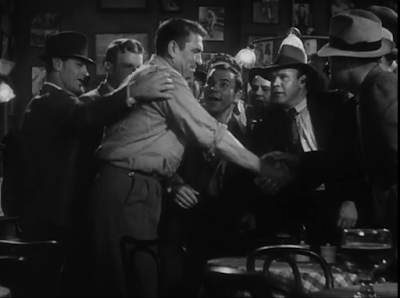Borden Chase is known as a writer of western screenplays, most notably for Anthony Mann, but when he was getting his start in pulp fiction his first specialty was virtually his own subgenre, based on his own experiences as a "sandhog" on work crews digging tunnels under rivers. In the pages of the weekly
Argosy, starting in 1934, Chase described the dangerous work of the mighty tunnel men, who worked in pressurized air that made them vulnerable to the bends but protected them -- most of the time -- from the crushing flood of the waters surrounding them. He broke into movies adapting his
Argosy serial
East River, which had already been picked up by Fox Film at the time of the first installment's appearance in October 1934. That issue announced on its cover that
East River would soon appear onscreen with Victor McLaglen and Edmund Lowe in the lead roles. Just four months later,
Under Pressure hit theaters. For all I know, Chase had sold Fox an original screenplay and then adapted it into a serial novel, with help from Edward Doherty.
The main characters seem tailor-made for McLaglen and Lowe's long-established battling-bros screen personae, dating back to the blockbuster war comedy
What Price Glory (1926), a lip-readers delight that spawned a series of Pre-Code sequels that saw the stars wreak havoc around the world. Here as there, the stars play ball-busting he-men for whom friendship is indistinguishable from angry rivalry for accolades or ladies' attention. Their sandhogs are working from one end of the East River as another team, led by an even greater asshole (Charles Bickford), vies for the prestige of meeting in the middle first. There's not much plot beyond that. If anything, the screenplay is more episodic than the pulp serial, a 72 minute feature necessarily being but a digest of the novel.
Above, Edmund Lowe kayoes a dues-paying Ward Bond.
That makes him credible when Victor McLaglen threatens to throw down with him (below).
The sandhogs -- a racially integrated workforce, though the blacks (in
Argosy, Chase identifies them as Senegalese) are segregated into specific grunt-labor roles -- struggle to avoid a catastrophic "blow" resulting from a tunnel leak, while an intrepid girl reporter (Florence Rice) befriends our main men after rescuing a co-worker from an attack of the bends. Naturally, Jumbo (McLaglen) and Shocker (Lowe) jostle for position with the reporter, though it's clear enough that Jumbo's heart ultimately belongs to Amy Hardcastle (Marjorie Rambeau), who runs a tavern catering to sandhogs. Ultimately, Jumbo's recklessness gives him a nearly-crippling case of the bends, which he conceals from his men to keep up their confidence. After all, he doesn't need two good legs for the last part of the process, which requires him to dig away at a wall of dirt with his bare hands, almost like a dog, to force his way into Bickford's tunnel before the hated rival does the opposite. In fact, Bickford gets through first, but is promptly put back through his hole, McLaglen following to deliver the
coup de grace.
Under Pressure isn't considered a major film in Raoul Walsh's filmography, but he gives the picture both the punch efficiency the story requires and a convincingly cramped and sweaty atmosphere in the tunnel scenes. More credit arguably belongs to whoever was responsible for the art direction that helps how dangerous the workplace is for the sandhogs. Walsh, the director of
What Price Glory and two sequels, was an old hand with McLaglen and Lowe, who are just what they need to be here and no more -- but maybe a little less, in the period of Code Enforcement. The only really uncomfortable aspect of the picture is Walsh's employment of black extras for a bit of eye-rolling comedy relief that I don't recall in the original serial, which tended to portray the Senegalese as silent but stalwart. You get used to stuff like that when you're a fan of Thirties films, of course, and if that describes you I think you'll find
Under Pressure a modest spectacle in a novel setting that preserves much of the pulpy flavor of the original story. It doesn't necessarily point to the Borden Chase of the great western screenplays, but unless you're an auteurist that shouldn't be a big deal.






No comments:
Post a Comment